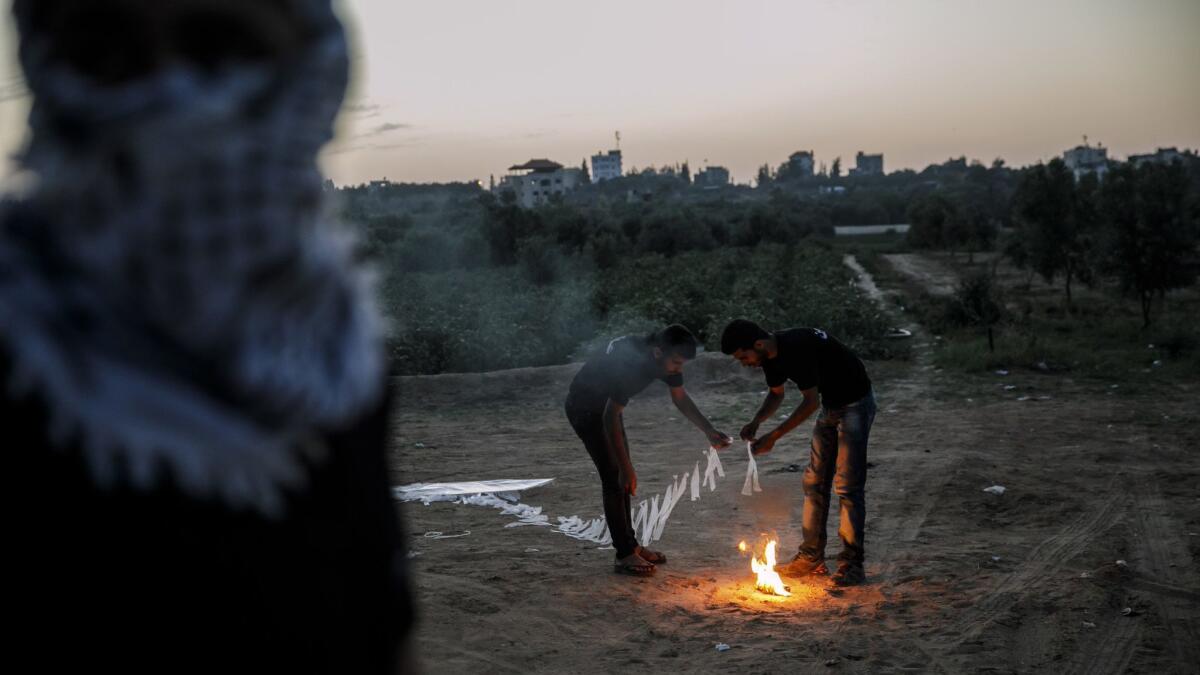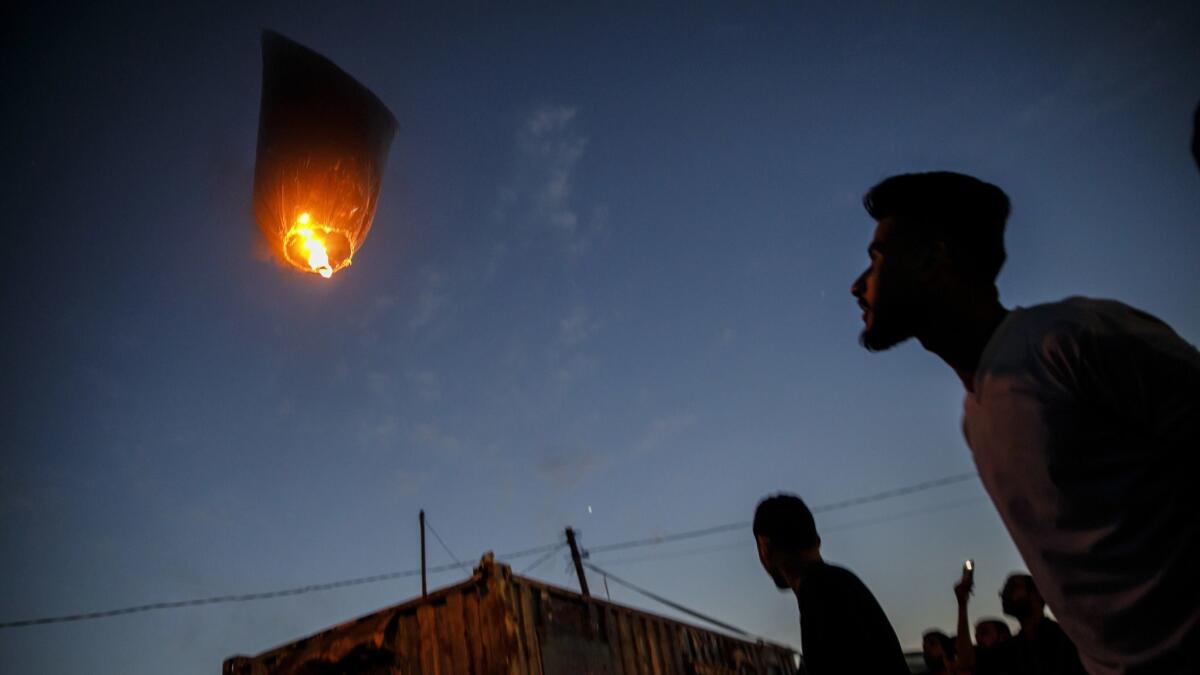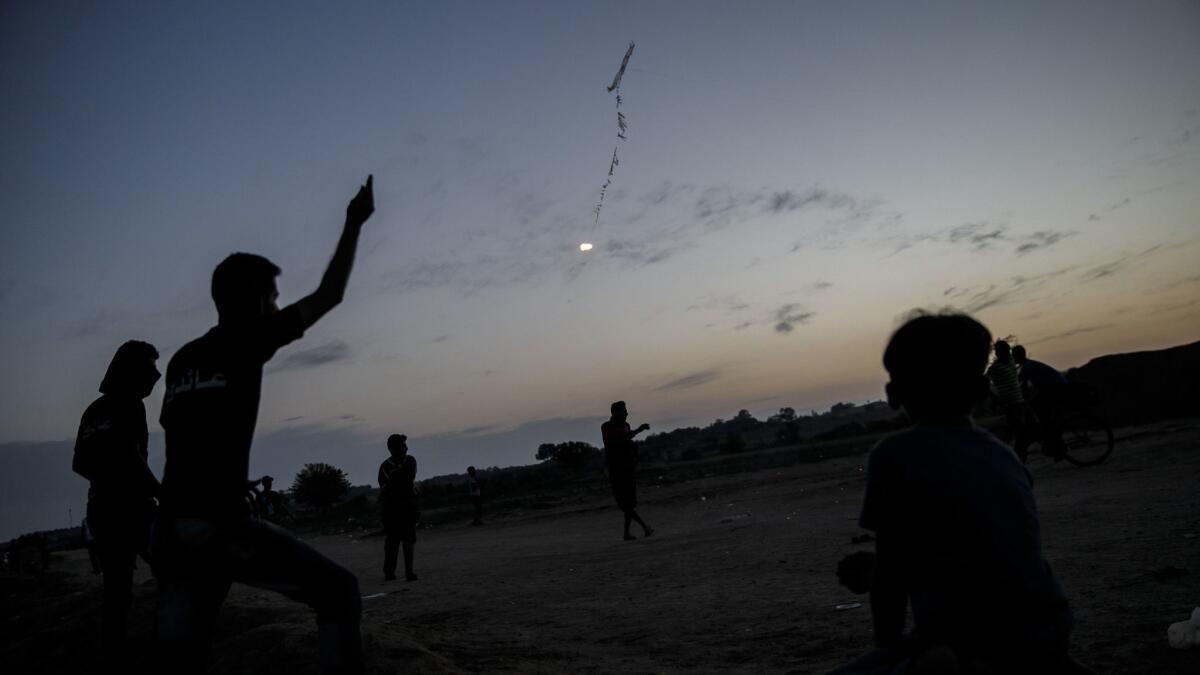Must Reads: They’re calling it the Kite War. How a simple plaything became a potent weapon in the Gaza Strip

- Share via
Reporting from Bureij Refugee Camp, Gaza Strip — No one guessed that kites would be the weapon to flummox the mighty Israeli army.
Yet kites and balloons, those summery playthings, have confounded a military that has succeeded in securing its border from every other challenge it has faced in the clashes that have rippled across its border with the Gaza Strip since late March.
For the record:
1:15 p.m. June 20, 2018An earlier version of this article gave the wrong figure for the acreage that has burned in Israel. It is 7,410, not 74,100. Also, this article states that about 130 protesters have been killed by Israeli troops, but those killed have included armed militants, a press photographer and a medic.
Kites trailing burning rags, and booby-trapped balloons carried aloft by winds heading inland from the Mediterranean, have caused the worst damage inside Israel since the wave of protests known as the Great Return March started.
At least 7,410 acres of farmland and national parkland have been incinerated by some 450 blazes sparked by the fire-bearing toys. Fourteen hundred acres of wheat have been lost.
Within Gaza, the kites’ success in harming Israel is seen as an unlikely triumph in a dark season in which about 130 protesters have been killed by Israeli troops, with thousands more injured in weekly Friday demonstrations at the border. On Monday, the Gaza Ministry of Health announced the death of 13-year-old Zakaria Beshbash, who was reportedly shot in the stomach during Friday’s protests.

Early Monday, Israeli air force planes struck what the army referred to as “nine military targets in two military compounds and in a munition manufacturing site belonging to the HMS terror organization,” referring to Hamas, the Islamist militia that rules the beleaguered Gaza Strip.
In a statement, the army said the strike, in which it said there were no casualties, was “in response to arson and explosive kites and balloons that have been launched into Israel.”
The army said it “considers the use of incendiary and explosive kites and balloons to be very grave and will work to prevent their use.” Later in the day, the military said its aircraft had targeted Hamas infrastructure in the southern Gaza Strip; it did not describe precisely what was hit.
About 5 a.m. Monday, Israelis in southern communities were awakened by air raid sirens as at least three rockets were launched from Gaza into Israel.
The escalation spilled over into two incidents later in the day. In one, a 24-year-old man was killed by Israeli army gunfire when a group of Gazans attempted to breach the border into Israel.
In another, the army said five men attempted to place an explosive device along the border fence and when it exploded, “a number of terrorists were hurt.”
“Israel and Hamas are on the verge of the First Kite War,” wrote Amos Harel, military analyst for the Israeli daily Haaretz. “Hamas is signaling to Israel it will respond with rockets if the kite fliers are targeted.”
For Israeli farming communities, the effect of the kites has been shattering.

Giora Almog, a retired kindergarten teacher living in Nahal Oz, an agricultural village a few hundred yards from the border, compared the destruction of golden wheat fields ready for harvest to an “attack against the womb of the nation.”
Scores of fields surrounding Nahal Oz have been reduced to blackened earth.
Firefighters battled blazes in southern Israel over the weekend; 17 were recorded on Sunday morning alone.
Kite-makers often come from the poorest stratum of Gaza’s hard-hit society. Some work with Hamas, many do not.
Rami, the head of one kite construction crew, said in an interview from the Bureij refugee camp that one of his volunteers was short the $2 he would need to get home after 30 days in the camp along the border.
None of the young Palestinian men interviewed for this article would agree to share their last names, out of fear that Israeli authorities would be able to identify and possibly target them.
Rami, 30, an organizer of the kite operation, said he was inspired on March 30, the day of the first rally, when he saw “a kite with the Palestinian flag attached to its tail lying on the other side of the fence.”
“We thought that maybe it could carry something else, like a Molotov cocktail, but realized it wasn’t practical,” he recalled.“Then we got the idea of setting it aflame.”
The kite-building group’s video of their first attempt to launch a fiery kite, posted on social media, drew skeptical responses, “but by the time we managed to develop the flame and people saw scenes of the burning fields on the other side, the guys got excited,” Rami said.

He builds the kites using flexible wood from a palm tree by his house.
Initially, the teams soaked sponges in diesel fuel, but soon realized the flame didn’t last long enough to have much impact. They then tried attaching folded remnants of denim, soaked in used car oil, to the kites.
Later, they advanced to helium balloons carrying Molotov cocktails — but continued to use kites as well.
Last week, the Israeli army announced it was curtailing the amount of helium gas it would allow into the Gaza Strip, a dense enclave of 2 million people. Maj. Gen. Kamil Abu Rokon, the official in charge, warned that helium, normally used by hospitals to operate MRI scanners, would be banned from the territory if its use “by terrorist elements to fire Molotov cocktails from the Gaza Strip into Israel” persisted.
The Palestinian Ministry of Health denied that helium was being used for the balloons and said any restrictions “will have serious impact on the lives of patients, especially those in need of magnetic resonance services, numbering over 3,000 patients per month.”
Recently, a growing proportion of the airborne flotilla has been made up of inflated condoms or party balloons bearing celebratory texts, both considered sturdier — not to mention snarkier — than conventional balloons. On Friday, a southern Israeli highway was blocked for an hour as sappers defused a booby-trapped balloon bearing the message I ❤️ YOU.
Another Israeli countermeasure backfired.
In a decision aimed at bolstering his right-wing base, Israeli Prime Minister Benjamin Netanyahu announced that money used to compensate farmers for up to half of their financial losses from the fires would be taken out of funds intended for the Palestinian Authority — Hamas’ bitter opponent, whose punitive sanctions against the militia have caused a significant exacerbation of the strip’s humanitarian crisis.

The Palestinian government described the move as “piracy and burglary,” and Hamas-linked social media accounts mocked the Israeli move.
Netanyahu is confronting a rebellion among right-wing ministers for whom the current quandary presents an opportunity to burnish populist credentials. On Sunday, senior military officers briefing the Israeli cabinet said that it would be “unjustified” to attack Gazans launching the kites into Israel. They suggested instead that Israel attack Hamas military targets, hoping that would pressure the organization to halt the flying arson.
On Monday, Education Minister Naftali Bennett, a hard-liner, declared that “whoever launches airborne weapons towards our communities is a terrorist and there is no restriction against shooting at him.”
Pre-harvest losses to Israeli farmers are calculated at about $2 million.
Ayyash, 31, another Bureij kite-maker, said his teams were working hard, because the kites “raise morale and the enthusiasm of the youth.”
The hands of Ahmad, one of his companions, were swollen from handling the blade-sharp threads used to guide the kites upwards and to the east. He said the thread was of the variety normally used to train tomato plants in greenhouses.
Issa, 28, talked about making the rounds of car repair shops asking for spare oil for the flames.
“Naturally, we’re all afraid of the [Israeli] shooting,” he said. “We’re only human, but this fear won’t stop us from continuing our peaceful protest to return to our lands.”
Special correspondents Salah and Tarnopolsky reported from the Bureij refugee camp and Nahal Oz, Israel, respectively.
UPDATES:
10:45 a.m.: This article has been updated with the Israeli military targeting Hamas infrastructure.
This article was originally posted at 9 a.m.
More to Read
Sign up for Essential California
The most important California stories and recommendations in your inbox every morning.
You may occasionally receive promotional content from the Los Angeles Times.










